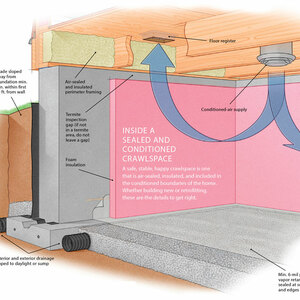No hot water, but two hot wires
My wife filled the tub and noticed the water was unusually hot, and that was the last hot water we’ve seen. When I removed the covers on the water heater, the hot wires from the thermostats to the elements were cooked–fried clean through with half the wires’ insulation melted or burned away.
Questions I have:
1. Assuming the thermostats are the culprits, why two at the same time?
2. The heater’s 8 years old. Time to replace, which I could do myself, or call someone to see about repairs (possibly just adding the cost of the house call to my expenses after they tell me it needs to be replaced)?
Thanks for your advice.


















Replies
Is the entire wire cooked, or just an end? If just ends are cooked that usually means a bad connection, either between wire and device or inside the device. If both wires are entirely cooked to one element then most likely the heater element is shorted out. If just the black wires are cooked, or the wires are cooked to more than one element then you have a weird failure mode.
In any event, given the failure mode, some trouble-shooting is in order before you attempt a repair, and there may be more concealed wiring damage than needs to be checked for.
Our electric heater is over 30 years old.
Yep, just the black wires are cooked, and only where they connect to the elements, and to both elements.Which puts me in what you accurately term "weird" territory. Which makes me wonder if this heater will be around as long as yours.
OK, so the black connections overheated on the elements, and on both elements.One thing you don't know is how long this was going on. The lower could have been out of action for months, and you might not notice -- you'd just seem to run out of hot water a bit too fast.In fact, the burned black wires may be a red herring -- it's possible that it's just a bad thermostat, and the wires, while "stressed" are still making halfway good contact.Anyway, you need to disconnect both wires from both elements (breaker off, of course!), then check the elements for short to ground and for continuity. (You can't easily check for an internal short, unfortunately.) Inspect the screw terminals on the elements -- if badly burned the elements may need to be replaced. (Or if they're open or show less than about 10K ohms to ground they'll need replacing, of course.)Then get some new wire (anyone know what grade of wire to use?) and replace the burned black wires. Probably would be good to use a LITTLE anti-oxidation grease on the wires where they connect. Tighten the connections pretty tight, loosen, then tighten again, to work loose any oxidation. Then get them REALLY tight. (Thermal cycling is a connection killer, and if a connection is even slightly loose it'll cascade to failure.)You should also probably just replace both thermostats (including the overtemp detecter on the top thermostat), since it's likely one of them failed, it's hard to diagnose which one, and thermostats are cheap and easy to replace. Once again, get the connections TIGHT.Inspect after an hour, a day, a week, for signs of the wires burning again. If they do, you need to replace the elements.
So convenient a thing it is to be a reasonable Creature, since it enables one to find or make a Reason for everything one has a mind to do. --Benjamin Franklin
This all sounds like excellent advice, DanH. The elements test out okay but because the terminals are toast, I'll replace them along with the thermostats. Mostly I posted because the fried wires puzzled me, and I don't like puzzles that involve catastrophic failure of an electrical component! Thanks again for the help.
It's hard to say without actually seeing the wires. It's not that unusual to find the wires a little scorched on the ends where they connect to the elements. I'm not sure that the wire they use is anything other than standard 105C stuff. Likely there's some variation with the quality of the element, too, with regard to how cool it keeps the wire terminals.I didn't recommend replacing the elements because it's a PITA. But definitely if you replace one, replace both.
So convenient a thing it is to be a reasonable Creature, since it enables one to find or make a Reason for everything one has a mind to do. --Benjamin Franklin
These wires were burned all the way through--totally severed from the terminals, the insulation burned or melted away almost 3" from the terminals, and the plastic block beneath the terminal half melted away. Kinda beyond the pale, to my mind.Both elements tested at about 14 ohms. I removed the upper element just now and there was some material bridging the electrodes, but just insubstantial "fluff."The wiring was 14 AWG, 600V, rated to 105 degrees C. Anything out of line there? My next challenge seems to be running the new hot wire to the lower element--I tried mightily to pull the old wire through the insulation and it snapped. Any tricks there, anyone?
Actually, #14 is a bit on the weak side. Should be #12 at least, maybe #10. What's your breaker size?14 ohms is about right, for an element in the 3500-4500 watt range. What wattage elements are they (should be on the nameplate).
So convenient a thing it is to be a reasonable Creature, since it enables one to find or make a Reason for everything one has a mind to do. --Benjamin Franklin
4500W elements, 30A breakers. I replaced a fuse-based main panel less than a year ago, but don't remember how many amps the circuit used to have.
Then that should probably be #10 wire. Any chance that some jackleg replaced the wiring at some point, vs that being factory wiring?
So convenient a thing it is to be a reasonable Creature, since it enables one to find or make a Reason for everything one has a mind to do. --Benjamin Franklin
Hot water again--what a luxury! I used 10 gauge replacement wire with the new components.Thanks for all your help.
Sounds like you may have stuck thermostat or a heating element that has failed. Turn the power off, disconnect the wires and use an ohm meter to check the elements. If they are good the thermostats must be bad.
Get a new set at the hardware store and replace. Buy the way, I find if an element has gone bad it is usually the bottom one so I can drain the whole tank instead of just the top 1/4.
use an ohm meter to check the elements
A good nelement will read right at 1 ohm.
A shorted element will read right at 1 ohm or less.
Depends on the wattage of the element and where it shorted.
You oughta see an element where the electrician energizes the heater before the plumber fills it after the cold water hits the red hot element.
This was the same job where the electrician wired the disconnect so it shorted the heater on one leg and the supply side on the other. At least the elements in that heater were still good.SamT
Anyone who doesn't take truth seriously in small matters cannot be trusted in large ones either. [Einstein] Tks, BossHogg.